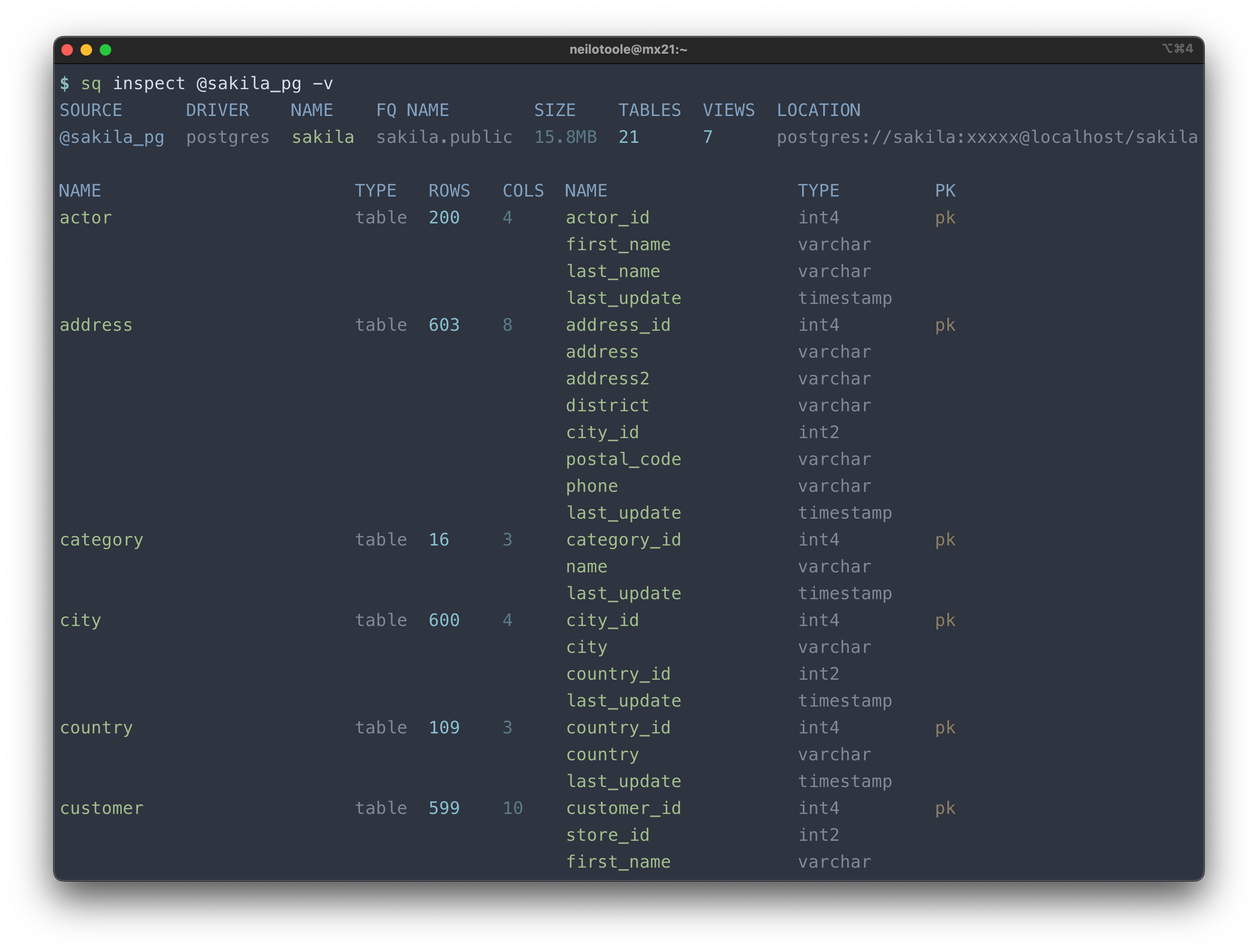sq inspect
sq inspect inspects metadata (schema/structure, tables, columns) for a source,
or for an individual table. When used with --json, the output of sq inspect can
be fed into other tools such as jq to enable complex data pipelines.
See the inspect guide for an overview of sq inspect.

Reference
Inspect a data source, or a particular table in a source,
listing table details such as column names and row counts, etc.
NOTE: If a schema is large, it may take some time for the command to complete.
If @HANDLE is not provided, the active data source is assumed. If @HANDLE.TABLE
is provided, table inspection is performed (as opposed to source inspection).
There are several modes of operation, controlled by flags. Each of the following
modes apply only to source inspection, not table inspection. When no mode flag
is supplied, the default is to show the source metadata and schema.
--overview: Displays the source's metadata, but not the schema.
--dbprops: Displays database properties for the sources' *underlying* database.
--catalogs: List the catalogs (databases) available via the source.
--schemata: List the schemas available in the source's active catalog.
Use --verbose with --text format to see more detail. The --json and --yaml
formats both show extensive detail.
Usage:
sq inspect [@HANDLE|@HANDLE.TABLE|.TABLE]
Examples:
# Inspect active data source.
$ sq inspect
# Inspect @pg1 data source.
$ sq inspect @pg1
# Inspect @pg1 data source, showing verbose output.
$ sq inspect -v @pg1
# Show output in JSON (useful for piping to jq).
$ sq inspect --json @pg1
# Show output in YAML.
$ sq inspect --yaml @pg1
# Show only the DB properties for @pg1.
$ sq inspect --dbprops @pg1
# Show only the source metadata (and not schema details).
$ sq inspect --overview @pg1
# List the schemas in @pg1.
$ sq inspect --schemata @pg1
# List the catalogs in @pg1.
$ sq inspect --catalogs @pg1
# Inspect table "actor" in @pg1 data source.
$ sq inspect @pg1.actor
# Inspect "actor" in active data source.
$ sq inspect .actor
# Inspect a non-default schema in source @my1.
$ sq inspect @my1 --src.schema information_schema
# Inspect piped data.
$ cat data.xlsx | sq inspect
Flags:
-t, --text Output text
-h, --header Print header row (default true)
-H, --no-header Don't print header row
-j, --json Output JSON
-c, --compact Compact instead of pretty-printed output
-y, --yaml Output YAML
-O, --overview Show metadata only (no schema)
-p, --dbprops Show DB properties only
-C, --catalogs List catalogs only
-S, --schemata List schemas (in current catalog) only
--src.schema string Override active schema (and/or catalog) for this query
--no-cache Don't cache ingest data
--help help for inspect
Global Flags:
--config string Load config from here
--debug.pprof string pprof profiling mode (default "off")
--error.format string Error output format (default "text")
-E, --error.stack Print error stack trace to stderr
--log Enable logging
--log.file string Log file path (default "/Users/neilotoole/Library/Logs/sq/sq.log")
--log.format string Log output format (text or json) (default "text")
--log.level string Log level, one of: DEBUG, INFO, WARN, ERROR (default "DEBUG")
-M, --monochrome Don't print color output
--no-progress Don't show progress bar
--no-redact Don't redact passwords in output
-v, --verbose Print verbose output